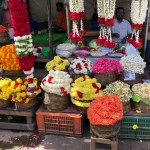The Bangalore region of South India is parched. There is virtually no visible water anywhere and the landscape is mostly stone and dust and the heat of the sun.
But there are trees. Trees perched on distant promontories of stone, trees on dusty rural roadsides, trees on urban streets rising above endless streams of rickshaws and buses. Trees used to tether animals, to hold up awnings, to lean scooters against. Trees heavy with jack fruit. Trees growing out of piles of trash. Trees that are marked with pigment in worship, sites of the sacred, themselves sacred. Trees along the roadside from which hang ropes with great clusters of coconuts at the end, discarded piles of coconut shells drifting down the embankment behind. An towering Aurai cookii rising up behind women in saris, planted by Queen Elizabeth II. An immense White Silk Cotton Tree that dwarfs all humans around it. Trees swarming with monkeys. Trees with roots like blades. Trees with impossibly wide canopies in a brilliant shade of new green that my camera fails to capture.
And then the stone: immense outcroppings of stone that rise above the plain. Pillars, courtyards, carvings, from a temple in the Nandi Hills that dates from the 900s. Everything baking in the heat, paving stones almost too hot to walk on in the requisite bare feet when visiting a temple. And then to pass between pillars and beneath the shade of the temple is a blessing: to stand on that cool stone refreshes like standing in a stream.
It is almost impossible to imagine my tree, buried in snow, raked with freezing rain, rising from a frozen landscape of white and gray. Unvisited and unclimbed. Cold as iron.
But life swirls on, and there are lunches on banana leaf plates, flower markets, street scenes. The extraordinary assault of colors, sights, sounds, smells.
It will be easier to remember my tree when I am wearing a down jacket and back among its branches.
Sent from my iPad



























